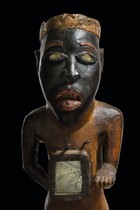Power figure "nkisi", before 1929 · D. R. Congo, Bakongo/Mayombe/Vili · ID: 3039560
Dutch Collection (1934)
English Collection
Gerd Hanebeck, Wuppertal, Germany (since 1987)
Gerd Hanebeck (*1939) is a german painter, graphic and object artist, living and working in Wuppertal. His artistic oeuvre is influenced by the cultures of Western Africa and the ritual cults of the Western African tribes. His oeuvre comprises paintings, sculptures, drawings, object cases, material pictures and works in terracotta. He himself has never been in Africa, which is why Hanebeck is jokingly called the “painting Karl May”.
Description
wood, reddish brown patina, black and red paint, eyes with glass inlay, striking large head rising from a thick neck, aggressively out-thrust jaw with an open mouth as if screaming, the stuck out tongue should provide protection from magical threat, right hand to the hip, the left with upturned palm presented to the viewer, the self confident pose emphasized by overlarge feet firmly resting on the ground, headdress with raised rim spread with mass, presumably once provided with cloth package or feather bunches, two boxes filled with magical material at the belly and at the back, each closed with mirror glass, iron aglets in the breast, slightly dam., minor missing parts (rim of the headdress), fine cracks, rep. (left forearm, rim of the headdress), base;
the “nkisi”-object is basically a container for animal, vegetable, and mineral materials known as “medicines” (“bilongo”) that expressed by their names, forms or provenance the aims that the “nkisi” was expected to achieve and the powers that enabled it to do so. In many “minkisi” (pl.) we might find leaves of the “lusakasaka” plant, that it might “bless” the supplicant. A single seed of “luzibu”, that it might “open” matters that are hidden or closed. “Kalazima” (charcoal) that it might “smite” evildoers, and always, white kaolin clay (“mpemba) to represent the presence of powers from the land of the dead. Most of the ingredients were first reduced to unidentifiable fragments or a powder. Besides its material apparatus, the complete “nkisi” entity included songs to be sung in its presence, invocations addressed to it, and behavioral restrictions observed by its “nganga” and the beneficiaries of the ritual. Lacking these, the figure in itself is powerless.
Comparing literature
Fagaly, William, Ancestors of Congo Square, New Orleans 2011, p. 344 ff.
Publications
Engel, R. & Eickhorst, A., Kunst in der Sparkasse: "Annäherung" - Hans Jürgen Hiby - Gerd Hanebeck, Wuppertal 2011, p. 47 f.Exhibition
"Annäherung" - Hans-Jürgen Hiby - Gerd Hanebeck, Wuppertal, September - November 2011






